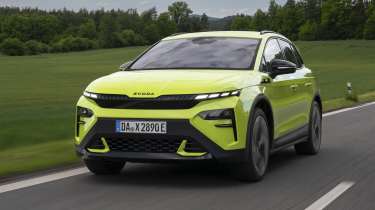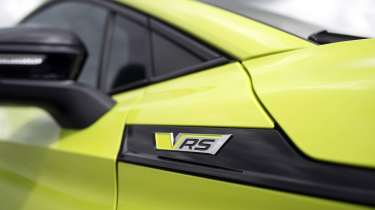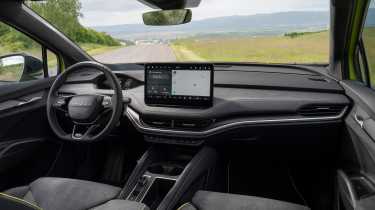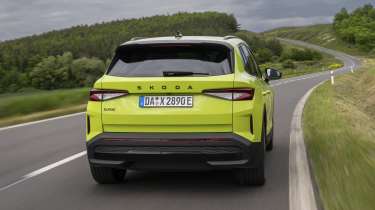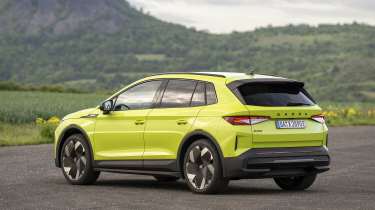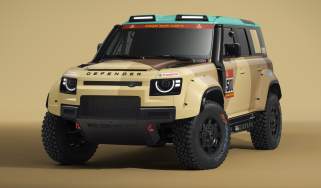Skoda Elroq vRS 2025 review – a sheep in sheep’s clothing
The swiftest-accelerating Skoda yet is an excellent electric family car but lacks excitement to back up its vRS badge
The Skoda Elroq vRS is a very pleasant car to drive. It has a lovely, measured response to its steering; there’s plenty of feel through its brake pedal, whether electric motor regen is active or not; it rides very well for a weighty car; handling is tidy and composed; and unlike some other EVs, which rely on the shock and awe of snap-instant torque to impress, it has a softly rounded (but still precise) edge to its throttle response, even in its raciest driving mode, so it neither makes you feel sick nor turns your passengers into nodding dogs.
All of the above makes it a car in which you can get into an enjoyable flow on a good bit of road. It’s a quietly agreeable and rewarding car to drive. It is not necessarily a car to be described as exciting, involving or inspiring, however. I haven’t driven the regular, non-vRS Skoda Elroq before but can’t rid a nagging feeling: if this car didn’t have a vRS badge, I’d assume it was that ‘normal’ model, rather than a performance variant.
What is the regular Elroq? It’s an all-electric compact SUV or crossover depending on your preferred nomenclature, with decent space for five people and a medium-sized boot. Prices start from £31,510. It launched around six months prior to this range-topping £46,560 vRS version. That gives Skoda four vRS performance models in its portfolio at present: besides the Elroq, there’s the Octavia vRS estate and saloon (the latter is currently on long-term test on evo’s Fast Fleet), the Kodiaq vRS seven-seat SUV, and the Enyaq and Enyaq Coupe vRS larger electric SUVs.
More reviews
Group tests
- Lotus Emira Turbo SE v Alpine A110 GTS – two of the last surviving mid-engined sports cars
- Alpine A290 v Alpine A110 – how much DNA do they really share?
- Ariel Atom 4R v Caterham Seven ‘evo25’: power-to-weight heroes go head-to-head
- Ariel Atom 4 v Caterham Seven 310R v Lotus Elise Cup 250
- £200,000 supercar shoot-out: AMG v Aston Martin v Maserati v McLaren
- Audi Quattro, RS2 and RS3: five-cylinder icons head-to-head
- Who makes the best GT car? Aston Martin v Bentley v Maserati
- Caterham Super Seven 600 v Super Seven 2000
- Corvette Stingray v Porsche Cayman GTS v Audi R8 RWD
- Great Ferrari hypercars driven: 288 GTO, F40, F50 and Enzo head-to-head
In-depth reviews
- Abarth 600e 2025 review – Italy gives the Alpine A290 something to worry about
- Alpine A110 review – the sports car Lotus should be building
- Aston Martin Vantage 2025 review – a thrilling Mercedes-AMG GT and 911 Turbo S alternative
- Used Audi RS2 (1994) review – an unsung '90s hero you can own for £40k
- Audi R8 (2015 - 2024) review – the ultimate soft-focus supercar
Long term tests
- Abarth 695C Turismo Fast Fleet test – living with the charming Italian hatch
- Alfa Romeo Giulia Veloce Fast Fleet test – living with the sharp Italian saloon
- Aston Martin Vantage (2006) Fast Fleet test – living with a £30k V8 Aston
- Caterham Seven evo25 Fast Fleet test – living with a track car for the road
- Caterham Seven evo Edition revealed – bespoke 420R joins the Fast Fleet
- Cupra Leon 300 Fast Fleet test – living with Spain's 300bhp hot hatch
- Cupra Ateca VZN Fast Fleet test – four months with Cupra's hot crossover
- Cupra Leon Estate 310 4Drive Fast Fleet test – living with the 306bhp hot estate
- Ford Mustang GT
- Ford Mustang GT
Review
- New Bentley Batur 2023 review – can it possibly be worth £1.65m?
- 2023 Chevrolet Corvette C8 Z06 review – the American 911 GT3?
- BBR Supercharged Mazda MX-5 (ND) 2023 review – tuned 250bhp roadster driven
- MG4 Trophy 2023 review
Reviews
- Abarth 695 75 Anniversario edition 2024 review – a fitting send-off for Abarth’s hot supermini?
- Abarth 500e 2023 review
- AC Cobra 378 Superblower MkIV 2021 review – another V8 Cobra, but with a GM heart this time
- Acura Integra Type S 2024 review – a Honda Civic Type R with added restraint
- Alfa Romeo Giulia 2025 review – get one while you still can
- Alfa Romeo 33 Stradale 2025 review – a rare Italian jewel beyond compare
- Alfa Romeo SZ: history, review and specs of an icon
The Elroq vRS has the honour of being the fastest accelerating Skoda production car yet made, with a 0-62mph time of 5.4 seconds. It’s also the fastest-charging, at up to 185kW at DC rapid chargers and the potential to top the battery up from 10 to 80 per cent in approximately 26 minutes. Regular Elroqs are powered by a single motor driving the rear wheels. The all-wheel-drive vRS is powered by two motors, one at the front axle, one at the back, with a total system output of 335bhp. The battery has a gross capacity of 84kWh, net 79kWh. The combined WLTP range is 339 miles. For context with regular Elroq models, the biggest-batteried 77kWh variants exceed 350 miles, whereas the smallest 52kWh version tops out at 233 miles.
Differentiating the vRS from ordinary Elroqs are different bumpers and various bits of gloss black painted exterior elements, including the side window trim, mirror caps, roof rails and Skoda lettering. There are 11 paint colours to choose from, one of them a matt grey unique to the vRS. There isn’t a vRS badge on the boot and from the back, or dead-on at the front, you could mistake this car for a regular Elroq. A nicely resolved design but not a particularly sporting one. To these eyes, particularly in white, it could be mistaken for a rental car. It’s a usefully slippery body, however, with a drag coefficient of 0.267. Side on, there’s a little more visual drama, with a lime green vRS badge on the flank and eye-catching vRS-specific alloy wheels.
They’re available in 20-inch in black or 21-inch with contrasting silver sections, lending more visual presence. We drove both versions, and ride quality was notably worse on the 21s; although that car had a curious vibration under acceleration that suggested its tracking may have taken a knock at some point. The bigger wheels also impact the car’s range a little, of course, nudging consumption from 3.8 miles per kWh (WLTP) to 3.7. Skoda has coloured the vRS badge lime green, to differentiate it from regular petrol models, which it plans to keep building and selling alongside its EVs for some years to come. ‘We won’t dictate to customers what they must drive, we will keep offering choice,’ Björn Kröll, head of product marketing tells evo. ‘We want to stand on two strong legs – petrol and electric – because it is extremely difficult to make predictions; [the market] is so volatile.’
The lime theme is continued inside, with green stitching to lift the interior ambience a little, together with some very sporty-looking seats with integrated headrests. They’re comfortable and electrically adjustable with plenty of scope to find a comfortable driving position. The driver’s seat includes a massage function as standard (also available as an extra-cost option for the passenger seat).
Quality feels largely very good although I do wonder how well the faux suede lining on the dashboard will stand up over the years, and there was some wonky stitching on our test cars’ headrests. With perforated microsuede upholstery, artificial leather and faux carbonfibre, a mildly sporty-looking three-spoke steering wheel with perforated trim and stainless steel caps over the pedals, it’s a largely sober interior with a low-key sporting vibe – the Elroq vRS’s character in microcosm. It's nice and roomy, with plenty of places to put things, in typical Skoda style. A five-inch digital instrument panel and large 13-inch touchscreen are standard, the latter a dominant feature of the dashboard. Also standard is an attractive and clear head-up display with active graphics for navigation instructions and vRS-specific graphics.
Top speed is a modest 111mph. Quite rightly, Skoda hasn’t chased a higher figure. ‘It doesn’t make sense for the car to do 250kph,’ Kröll tells evo. ‘It has the power, but it would require a two-speed gearbox, and the consumption would be higher.’ Nor has it fitted more powerful brakes to the vRS; like the regular Elroq, it has drums at the rear, since it can utilise the electric motors for deceleration. Skoda deemed that there was no need to increase unsprung mass by fitting bigger brakes. There have been no stiffening measures applied to the structure, either. This is a car more about powertrain than chassis.
Regenerative braking is looked after automatically but you can also choose three pre-set levels of regen, triggered by paddles behind the steering wheel, which you can use to mimic the effect of downshifting through a gearbox while approaching a corner. If you’re in Normal mode, after a few seconds the regen mode defaults back to auto. In Sport, it defaults to the middle regen level – perhaps to tip a little weight onto the nose on the way into corners, and make the front end feel extra-positive.
We’re testing the car in the north of the Czech Republic, not far from where it’s manufactured, on a mixture of motorway and smooth and rough country roads.Suspension is by MacPherson strut at the front and multi-link rear. Dynamic Chassis Control (DCC) electromagnetic adaptive dampers are fitted as standard, with 15 stages from soft to firm to choose from via the touchscreen, as per other VW Group products such as the VW Golf GTI, Cupra Leon – and the VW ID.4 GTX, with which the Elroq vRS has plenty in common. Both are built around the group’s MEB platform and feature the same dual-motor set-up and 335bhp output. The Skoda is considerably cheaper at the time of writing than the GTX, which tops £52,000.
Aside from sliding your finger along the screen to choose your desired level of damping, there is a typical suite of driving modes, including a softer Comfort setting alongside Normal. Body control can be a little wallowy in Comfort mode, where you can hit a bump and feel the body keep moving after the fact. But in Normal and Sport, it looks after itself well. Ride is really very good for the most part, it’s only occasionally that a little lumpiness likely caused by necessarily stiff springs makes itself known. Pressing on, the Elroq can feel a little top-heavy at times but overall it’s a stable, supple car.
Although Kröll tells evo suspension changes are largely a case of geometry tweaks and fine-tuning compared with the regular Elroq, Skoda states that the vRS carries stiffer anti-roll bars, and rides slightly lower than the standard car, with the DCC software recalibrated accordingly. The progressive steering set-up – a variable ratio according to lock – has likewise been recalibrated.
Refinement is impressive. It’s a quiet car, well insulated from road and wind noise alike. Skoda has chosen not to include any false ‘engine’ sounds, though you can choose from two different exterior sounds audible to pedestrians (a mandatory feature by law): Sport and Futuristic. With the windows down, you can vaguely hear the external note. We noticed that in the Sport driving mode, the external sound changes accordingly. The lack of synthesised sound inside the car does perhaps contribute to the lack of drama, and like many EVs, it’s easy not to realise just how swiftly you’re travelling at times.
The Elroq vRS can be deceptively rapid point-to-point. It’s the sort of car you could cover ground in very quickly without ever feeling flustered, and spring a surprise on many more serious performance cars. As well as eschewing synthesised interior noises, it’s commendable that Skoda has given the car a relatively gentle ‘throttle’ map. Subjectively, I wonder if it may be too subdued; I don’t necessarily want Tesla-style shock and awe, but the response could feel a little sharper in the sportier driving modes.
Skoda vRS models have never been extreme cars, however. Nor does the badge have the same emotional heft as, say, GTI at Volkswagen, and Skoda has more flexibility to apply it to cars with differing characteristics. You could argue that an understated, well-mannered car such as the Elroq vRS is entirely appropriate. But to this tester, this feels like a car that wouldsuit a Sportline badge rather than a vRS one.
The regular Elroq is doing very well. In April, it was Europe’s best-selling battery-electric vehicle and had totalled 70,000 orders by the end of May. Arguably Skoda didn’t need to build anything more dramatic than this vRS, and it is the only Elroq offered with dual motors and all-wheel-drive. But it feels like it could have made more of the car than some black trim, nice seats, DCC as standard and lime stitching. Nonetheless, both the Elroq and Enyaq vRS models are the first models of their type for Skoda. They’re at the beginning of a journey and future battery powered vRS models may well become more innovative and more exciting.
For now, the Skoda Elroq vRS is a very good car, just a slightly forgettable one.
